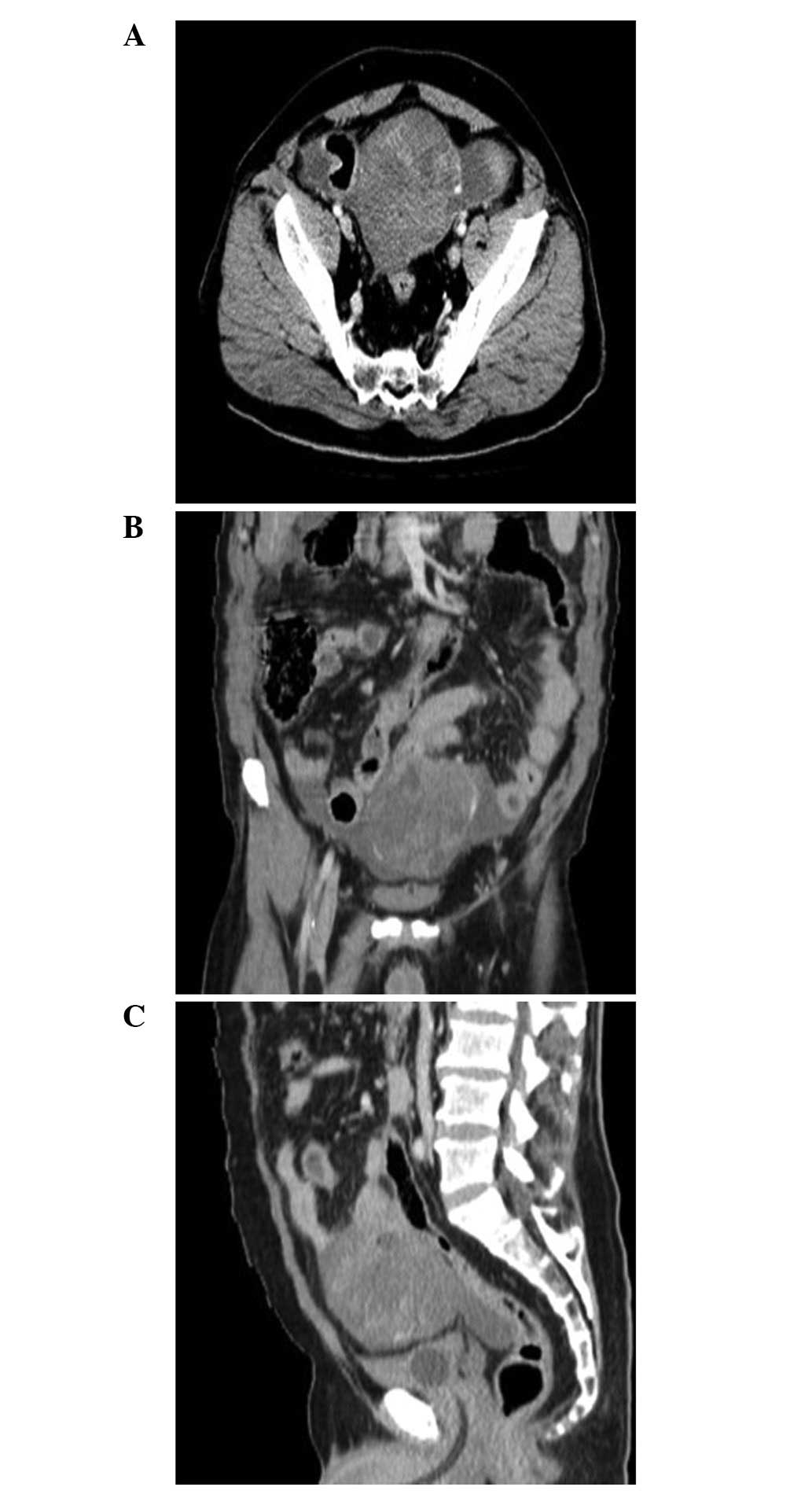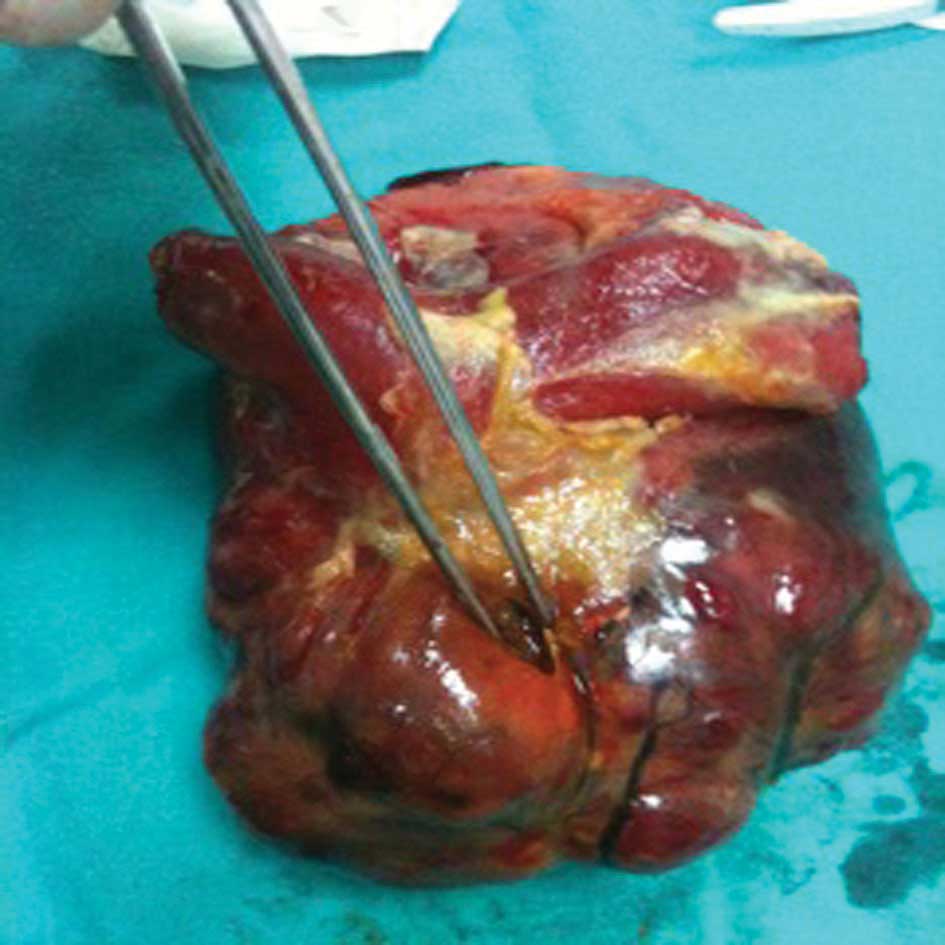Perforated gastrointestinal stromal tumor in the jejunum: A rare cause of acute abdomen
- Authors:
- Published online on: September 14, 2012 https://doi.org/10.3892/ol.2012.917
- Pages: 1244-1246
Abstract
Introduction
Gastrointestinal stromal tumors (GIST) are mesenchymal tumors of the digestive tract that originate from interstitial Cajal cells and account for 0.1–3% of all gastrointestinal tumors. They are usually located in the stomach and small intestine (1), but they can be located anywhere in the gastrointestinal tract, including the omentum and peritoneum. Generally, GISTs have a silent behavior and are diagnosed incidentally. Approximately 40% of GIST cases cause intestinal bleeding (2). Perforation is rarely observed in GISTs; however, we present a case of perforated GIST located in the jejunum as a rare cause of acute abdomen.
Case report
A 59-year-old male was admitted to the emergency department of the Bezmialem Faculty of Medicine Hospital with acute abdominal pain during the previous 20 h. The patient had no complaint of nausea or vomiting; however, the patient did have a history of diabetes mellitus type II and had undergone a coronary artery bypass surgery 6 years previously. On admission, the patient’s vital signs were stable, while his physical examination revealed abdominal distention, generalized tenderness and guarding. No palpable mass was revealed on physical examination due to abdominal guarding, and bowel sounds were hypokinetic. Blood cell count was 9,800 cells/μl (normal range, 4,000–11,000 cells/μl) and the C-reactive protein value was 6.5 mg/dl, which was 13 times the upper range (normal range, <0.5).
A contrast enhanced computed tomography (CT) scan revealed a 12x10x9-cm mass located at the level of the pelvic inlet on the midline posterosuperior to the urinary bladder with a solid character containing centrally necrotic areas and well-vascularized periphery (Fig. 1). Free fluid was identified around the mass, and nearby intestinal structures were inflamed. A laparotomy was conducted immediately. Subsequently a 12-cm diameter mass was identified in the jejunum located 150 cm from the Treitz’s ligament, and a small perforation area was observed at the medial side of the mass (Fig. 2). Generalized free fluid colored by bile was detected in the abdomen, while fibrinous inflammation and pseudomembranous colitis were identified around the mass, particularly on the intestinal structures in the pelvis. Segmentary jejunal resection, including the mass lesion, with clear macroscopical margins was conducted (Fig. 3). Handling was avoided to prevent the risk of having to conduct end to end anastomosis due to the dirty content of the abdomen and to maintain a safer approach to the patient. We anastomosed the posterior walls of each side and made a loop jejunostomy from the right lower quadrant. Histopathological investigation of the specimen revealed interlaced bundles of spindle-like tumor cells with high mitotic figures [7/50 high-power field (HPF)], and a Ki-67 value of 8%. Immunohistochemical results were C-KIT (Fig. 4A) and DOG1 positive (Fig. 4B), CD34 focally positive, S-100 positive, and smooth muscle actin (SMA) and desmin negative. As a result of these findings, the tumor was diagnosed as a GIST. A total of 6 lymph nodes were harvested, of which all were nonspecific. Surgical margins were confirmed as clear and the postoperative period was uneventful, so the patient was discharged on the 10th postoperative day.
Discussion
GIST is a visceral tumor arising from any site of the gastrointestinal tract. Approximately 60–70% of cases occur in the stomach, 25–35% in the small intestine and 10% in the jejunum, while the esophagus, colon, rectum and appendix are rarely affected (1). Approximately 10–30% of patients with GISTs may be asymptomatic. The most common symptoms associated with jejunal GISTs are vague, non-specific abdominal pain or discomfort. Patients who have jejunal GIST usually suffer from abdominal pain or palpable mass, and also complain of early satiety or abdominal fullness. Jejunal GISTs may cause symptoms secondary to obstruction or hemorrhage. Pressure necrosis and ulceration of the overlying mucosa may cause gastrointestinal bleeding, and patients who experience significant blood loss may suffer from malaise and fatigue. Obstruction may result from the intraluminal growth of the tumor or luminal compression from an exophytic lesion. Fever, anorexia and weight loss are rarely observed (2) and GISTs originating from the jejunum seldom cause perforation and acute diffuse peritonitis (3–6).
It is difficult to diagnose a jejunal GIST preoperatively due to the nonspecific and variable clinical symptoms, and it is also difficult to distinguish the tumor based solely on images. Although a CT scan is a commonly offered imaging modality for patients with suspected abdominal GISTs, magnetic resonance imaging (MRI) provides better information than CT in the preoperative workup (7). The definitive diagnosis of the majority of jejunal GISTs is revealed by histopathological examination of the specimen. Approximately 95% of GISTs express CD117, which is part of the KIT receptor tyrosine kinase. Additionally, DOG1, a recently defined monoclonal antibody against a chloride channel protein expressed by GIST, is positively expressed in 95% of GISTs (8). DOG1 is a novel marker of GISTs as it has a higher sensitivity and specificity compared with CD34, particularly in the detection of moderate and high risk GIST. Therefore, the present case was diagnosed by immunohistochemical examination of C-KIT and DOG1 positivity.
To date, surgery is the only potentially curative therapy for patients with primary, resectable GIST. Nonmetastatic GISTs greater than 2 cm should be resected. A lymphadenectomy is not conducted because lymph node metastases are rare (9). Although the size of tumor in this case was large, there were no harvested positive lymph nodes in the present case. The management of GIST has undergone significant revolution over last decade. Tyrosine kinase inhibitor therapy has significantly improved overall survival in patients with advanced disease and should be continued indefinitely. Prior to the development of imatinib, recurrences were common even in patients undergoing surgery. Adjuvant imatinib for 3 years should be considered in patients undergoing resection for primary disease (10).
In conclusion, we report a case of a male with a perforated GIST in the jejunum causing acute diffuse peritonitis. The clinical outcome is worse when this tumor presents with bowel perforation and peritonitis; therefore, if an abdominal mass presents with diffuse peritonitis, the possibility of jejunal GIST perforation should be considered, even though it is extremely rare. A high degree of suspicion is necessary in view of the high morbidity rates resulting from a delayed diagnosis of the disease.













